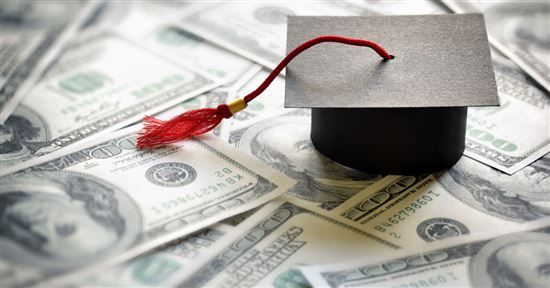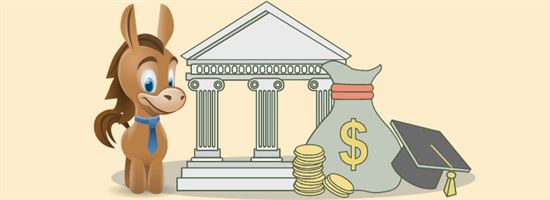Student Loan Debt Statistics
Student loans are the fastest growing consumer debt in America. How many students have loans? What does the average graduate owe? Read on for answers to all your student loan debt questions.
 |
The student loan debt crisis is real. Besides mortgages, student loans are now the leading type of debt in the U.S. Consider these statistics:
- The average graduate left college with $37,172 in student loan debt. The average monthly student loan payment is $351.
- Americans owe $1.5 trillion in student loan debt.
- 44 million borrowers still owe student loans.
Keep reading to learn more about one of America's largest debts.
3 Facts Every College Grad Needs to Know
 |
| © CreditDonkey |
- How much debt does the average college graduate have?
The average graduate leaves college with $37,172 in student loan debt. Ten years ago, that same student left had just $20,000 in student loans. - How many college students have student loans?
Seven out of 10 college students now leave college with loans. - What is the average student loan monthly payment?
The average student loan monthly payment remains at $351. In 2005, the average payment was $227 after adjusting for inflation.
Visit Federal StudentAid. While there, check out the
Student Loan Debt - The Basics
- What is student debt?
Money you borrow to pay for higher education is student debt. There are many types of student loans, including those for public and private schools. - What was the average student loan debt in 2018?
in 2018, students finishing college graduated with an average balance of $37,172 in student loan debt. That number is actually 5.6% lower than the previous year's total.Student Loan Debt by Year- 2018 - $37,172
2017 - $39,400)
2016 - $32,731
2015 - $30,100
2014 - $28,950
2015 - $28,400 - How much has student loan debt increased?
Since 2004, the number of students with loans increased from 65% to 69%. What has changed drastically, however, is the average amount of debt. It's grown almost twice the rate of inflation. - How many college students have subsidized loans?
The Department of Education pays accrued interest on subsidized student loans. This year 6.9 million borrowers held these loans. - How much student debt do parents owe?
As of late 2018, over 3 million parents hold a collective $90 billion in student loan debt for their children's college education. - What percentage of parents are concerned about paying for college?
74% of parents are Very (40%) or Somewhat <34%) worried about paying for college, according to a 2017 survey by Discover Student Loans.Surprisingly, only 45% of those surveyed completed the Free Application for Student Aid (FAFSA). Without this application, families are ineligible for federal student aid or even grants.
If you can't afford the standard repayment for a federal loan, there are four income-driven plans. Speak with your loan servicer to determine the right option for your financial situation.
Interest Rates and Trends
- How much student debt is there?
According to the Federal Reserve, Americans have a total of $1.3 trillion in student debt. - What is the average interest rate on a student loan?
Interest rates depend on the types of student loans.- Federal subsidized or unsubsidized loans disbursed after July 1, 2018 and before July 1, 2019 have a fixed interest rate of 5.05%.
- If you are graduate or professional-level borrower, your interest rate is fixed at 6.6%.
- For parents taking out Direct PLUS loans, the interest rate is fixed at 7.6%.
You Should Know: Private student loans may have either fixed or interest rates. These are based on your credit, income, and debt ratio. - How much higher are interest rates in 2018-2019?
Current federal direct loans have a fixed interest rate of 5.05%. That's 13% higher than last year's rate of 4.45%. - What fees does the government charge for federal student loans?
Most federal student loans include fees within the total loan amount. These are deducted from your payments.Federal loans disbursed before October 1, 2019, and after October 1, 2018, have fees of 1.062% of the total loan amount.
Those disbursed before October 1, 2018, and after October 1, 2017, have fees of 1.066% of the loan total.
- What's the maximum federal loan amount for an undergraduate?
Dependent students can receive the following loan amounts from the government:- 1st year of college: $5,500 ($3,500 max in subsidized loans)
- 2nd year of college: $6,500 ($4,500 max in subsidized loans)
- 3rd and 4th year of college: $7,500 ($5,500 max in subsidized loans)
- 1st year of college: $5,500 ($3,500 max in subsidized loans)
Student Loan Debt by Degree
- What is the average debt for a Bachelor's degree?
Graduates with a Bachelor's degree will leave school with an average of $35,000 in debt. - What is the average debt for a master's degree?
The average student debt for graduates with a Master's degree is $59,000. Grad students account for about 40% of the total amount of student loan debt.Average debt for different Master's degrees- MBA: $66,300
- Master of Education: $55,200
- Master of Arts: $72,800
- Master of Science: $62,300
- Other Master's Degrees: $75,100
- MBA: $66,300
- What is the average student debt for a Doctorate (Ph.D.)?
The average student loan debt for those with a Doctorate degree is $156,100. Health and medicine Ph.D students have it worse, with an average of $224,200.
Student Loan Repayment
- How many years does it take to pay student loans?
The standard repayment period for federal student loans is 10 years. This is the default plan for every borrower.If you can't afford the payment, discuss it with your loan servicer. There are several repayment plans available.
- How much more will the standard repayment plan cost borrowers?
A borrower with an average $34,000 in debt will pay $1,300 more in interest.Related: Best Student Loan Refinance - How long is the grace period on student loans?
You have a 6-month period after you graduate or leave college before you need to start repaying your loans. This doesn't include PLUS or Perkins loans, however.And as long as you stay enrolled at least half-time, you won't need to start repaying your loans.
- How many college graduates signed up for PSLF?
As of late 2018, over 41,000 borrowers applied for PSLF, or Public Service Loan Forgiveness. Only 206 students had their loans forgiven.The PSLF program forgives federal student loans for graduates who work in public service. The program requires at least 10 years in public service and only federal loans are eligible for forgiveness.
For more information and other criteria, check out our article.
Student Loan Forgiveness
Under current Federal Income-Driven Repayment Plans, your student loan balance may be forgiven after 20 or 25 years. Eligibility for these plans depends on the type of loans you have, your income, location, and family size.
Delinquent and Defaulted Loans
- How many borrowers default on student loans?
Every day 3,000 borrowers default on their student loans. That's 1.1 million people default each year. Default occurs when loan repayment is 270 days past due. - What percentage of loans are in default/delinquent?
About 11% of all student loans are either delinquent or in default, according to the Federal Reserve. This accounts for about $101.4 billion in student loans. - Can the government garnish wages for unpaid federal loans?
Wage garnishment is one way the government can collect on your student loan debt.At 360 days past due, they accelerate the loan, which means you owe the total remaining balance. They may also send it to a collection agency.
If this does not resolve the issue, they can garnish wages up to 15% or even seize your tax returns.
- How can I avoid defaulting on my student loans?
If you are unable to keep up with your federal loan payments, you can submit a request for loan forbearance or deferment to temporarily stop payments or reduce payment amount.Eligibility requirements will vary, so be sure to research the details on the StudentAid website.
- What's the difference between loan forbearance and loan deferment?
Your loans will continue to accrue interest in forbearance, but not in deferment. In other words, with forbearance, the balance of your loan continues to grow.Also, forbearance will only delay payments for up to 12 months whereas deferment can delay payments for up to 3 years. As such, deferment is the only option that applies to graduates returning to school.
If so, consider consolidating your federal student loans. You can reduce your loans to a single monthly payment, receive a lower median interest rate and extend your repayment period to up to 30 years.
Effects of Student Loan Debt
- Do student loans affect your credit?
Payment history accounts for 35% of your credit score, so paying your student loans on time will help your score increase. But missing payments will have a negative effect, especially if your loans go into default.Defaulted student loans can decrease your score by as many as 100 points. This will be reflected on your credit report for 7-10 years. Keeping up with payments over a long period of time indicates a longer credit history, another factor used to determine credit scores.
- How many college graduates move back home?
Almost half of 18-24-year-olds live at home after graduation. Of this number, 19% have at least a bachelor's degree. - What is the unemployment rate with a bachelor's degree?
Adults aged 25 and older with at least a bachelor's degree have a 2.5% unemployment rate. This rate remained steady from 2016. The overall unemployment rate for everyone was 48% higher at 4.8%.
Bottom Line
Student loans can help finance a college education. But make sure you exhaust all options, including grants, before applying.
Once you graduate, speak to your loan officer about terms and officers. You may want to consider an income-driven repayment plan, which may be eligible for loan forgiveness in the future.
Write to Kim P at feedback@creditdonkey.com. Follow us on Twitter and Facebook for our latest posts.
Note: This website is made possible through financial relationships with some of the products and services mentioned on this site. We may receive compensation if you shop through links in our content. You do not have to use our links, but you help support CreditDonkey if you do.
Read Next:






